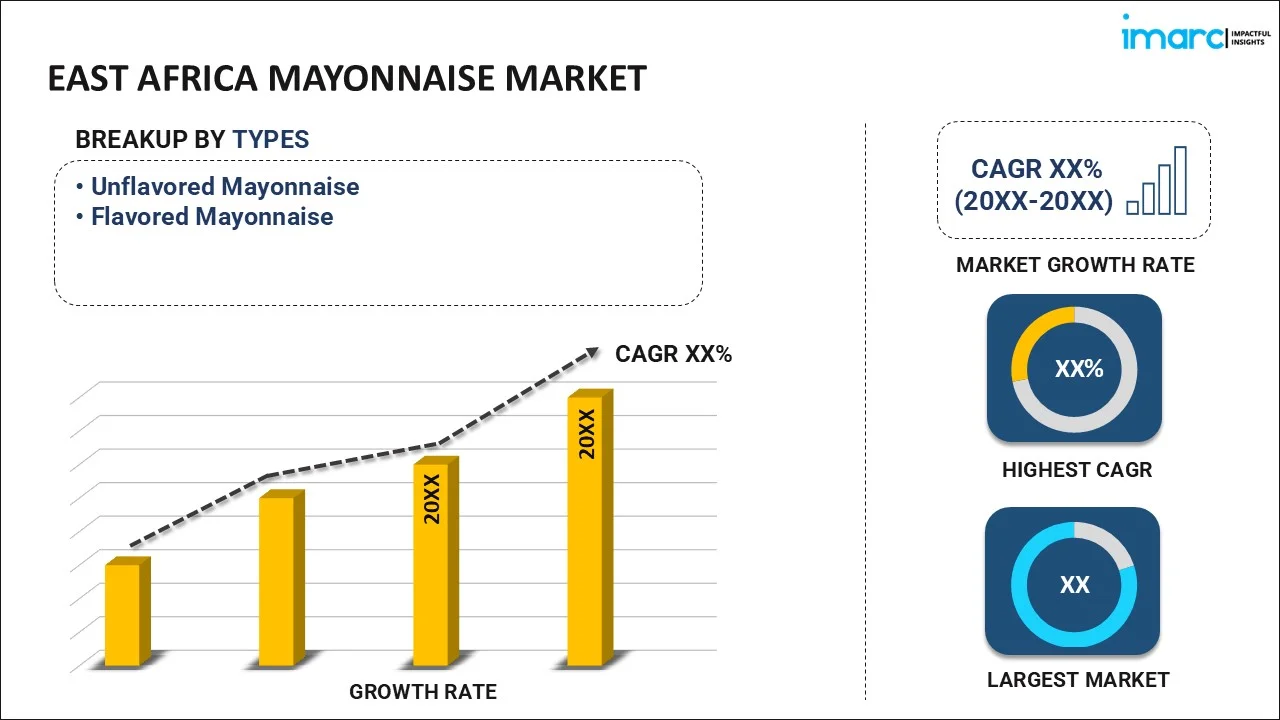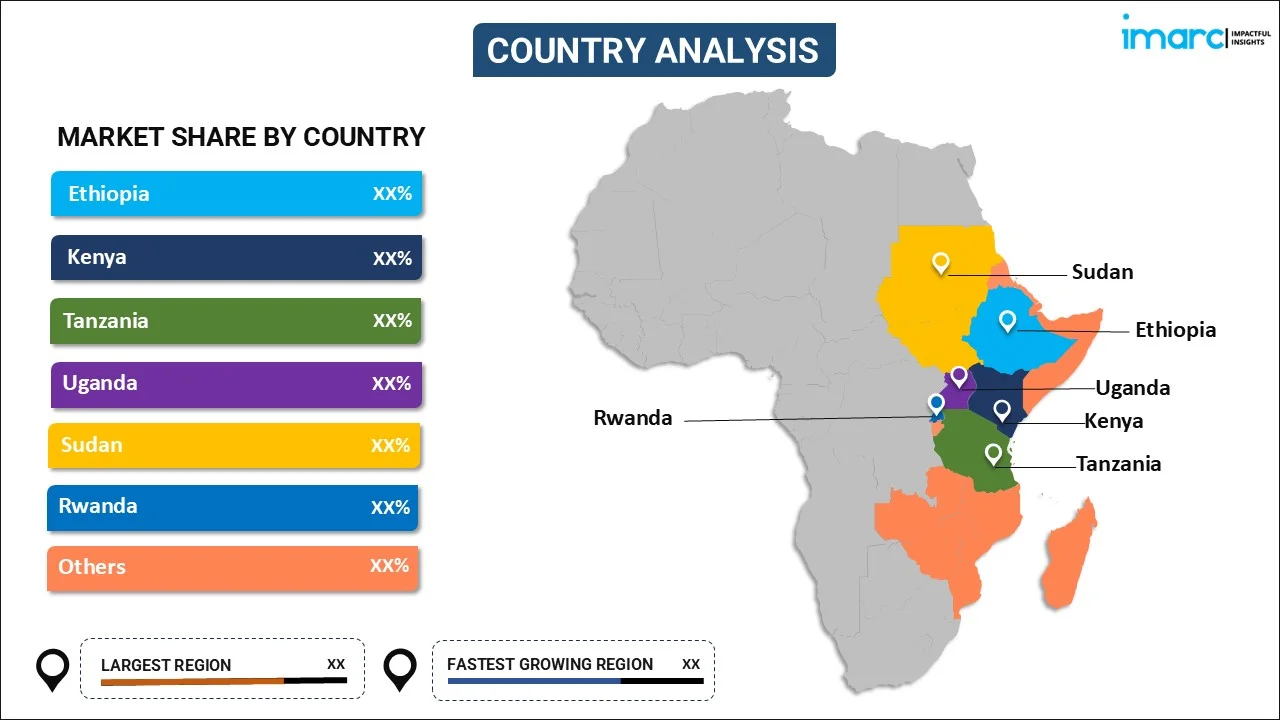
East Africa Mayonnaise Market Report by Type (Unflavored Mayonnaise, Flavored Mayonnaise), End Use (Institutional, Retail), Distribution Channel (Supermarkets and Hypermarkets, Convenience Stores, Online Retailers, Specialty Store, and Others), and Country 2024-2032
Market Overview:
The East Africa mayonnaise market size is projected to exhibit a growth rate (CAGR) of 6.38% during 2024-2032. The rapidly changing consumer preferences, increased urbanization, growing foodservice industry, significant product innovations, effective marketing and promotion strategies, easy availability of the products through e-commerce platforms, and increasing export opportunities for manufacturers represent some of the key factors driving the market.
|
Report Attribute
|
Key Statistics
|
|---|---|
|
Base Year
|
2023 |
|
Forecast Years
|
2024-2032 |
|
Historical Years
|
2018-2023
|
| Market Growth Rate (2024-2032) | 6.38% |
Mayonnaise is a creamy condiment that serves as a popular addition to a wide range of dishes. It is primarily composed of three key ingredients, namely egg yolks, oil, and vinegar or lemon juice. The process of making mayonnaise involves emulsifying these ingredients, which means blending them together to create a thick, stable mixture. This emulsification process is typically achieved by slowly adding oil to the egg yolks and vinegar or lemon juice while continuously whisking or blending the mixture. Mayonnaise is known for its rich, smooth texture and a slightly tangy flavor, making it a versatile ingredient in various culinary applications. Its neutral taste allows it to complement both savory and sweet dishes. Many individuals use mayonnaise as a base for salad dressings, sandwich spreads, and dips. It is also found in recipes for coleslaw, potato salad, and as a topping for burgers and sandwiches.
East Africa Mayonnaise Market Trends:
East Africa has witnessed a shift in consumer preferences toward Western-style foods, including sandwiches, burgers, and salads, where mayonnaise is a common condiment. As lifestyles change and urbanization increases, the demand for convenient and ready-to-use condiments like mayonnaise escalated significantly. Additionally, rapid urbanization in East Africa has led to busier lifestyles and an increased reliance on quick and convenient food options. Due to this, mayonnaise is widely used as it enhances the flavor of various dishes and can be easily incorporated into fast-food offerings. Other than his, the expanding foodservice industry in East Africa, which includes restaurants, fast-food chains, and catering services, has contributed to the rising demand for mayonnaise. Foodservice establishments frequently use mayonnaise as a key ingredient in their menus, driving up the consumption of this condiment. Besides this, while mayonnaise is traditionally associated with indulgence, manufacturers are adapting to consumer demands for healthier options. This has led to the development of low-fat, light, and vegan mayonnaise products in response to the growing health and wellness trends in the region. In line with this, as economies in East Africa continue to grow, the affordability of mayonnaise has improved, making it accessible to a broader segment of the population. Furthermore, the manufacturers are exploring export opportunities to neighboring countries, expanding their market reach and contributing to overall market growth. Apart from these factors, effective marketing and promotional strategies by mayonnaise brands have contributed to increased consumer awareness and brand loyalty. Companies are investing in advertising campaigns and digital marketing to connect with their target audience effectively. Moreover, mayonnaise manufacturers in East Africa are continually innovating to cater to diverse consumer tastes. They are introducing new flavors, packaging formats, and sizes to meet the evolving preferences of consumers and maintain a competitive edge in the market.
East Africa Mayonnaise Market Segmentation:
IMARC Group provides an analysis of the key trends in each segment of the market, along with forecasts at the regional and country levels for 2024-2032. Our report has categorized the market based on type, end use, and distribution channel.
Type Insights:

- Unflavored Mayonnaise
- Flavored Mayonnaise
The report has provided a detailed breakup and analysis of the market based on the type. This includes unflavored mayonnaise and flavored mayonnaise.
End Use Insights:
- Institutional
- Retail
A detailed breakup and analysis of the market based on the end use have also been provided in the report. This includes institutional and retail.
Distribution Channel Insights:
- Supermarkets and Hypermarkets
- Convenience Stores
- Online Retailers
- Specialty Store
- Others
The report has provided a detailed breakup and analysis of the market based on the distribution channel. This includes supermarkets and hypermarkets, convenience stores, online retailers, specialty store, and others.
Country Insights:

- Ethiopia
- Kenya
- Tanzania
- Uganda
- Sudan
- Rwanda
- Others
The report has also provided a comprehensive analysis of all the major regional markets, which include Ethiopia, Kenya, Tanzania, Uganda, Sudan, Rwanda, and Others.
Competitive Landscape:
The market research report has also provided a comprehensive analysis of the competitive landscape in the market. Competitive analysis such as market structure, key player positioning, top winning strategies, competitive dashboard, and company evaluation quadrant has been covered in the report. Also, detailed profiles of all major companies have been provided.
East Africa Mayonnaise Market Report Coverage:
| Report Features | Details |
|---|---|
| Base Year of the Analysis | 2023 |
| Historical Period | 2018-2023 |
| Forecast Period | 2024-2032 |
| Units | US$ Million |
| Scope of the Report | Exploration of Historical Trends and Market Outlook, Industry Catalysts and Challenges, Segment-Wise Historical and Future Market Assessment:
|
| Types Covered | Unflavored Mayonnaise, Flavored Mayonnaise |
| End Uses Covered | Institutional, Retail |
| Distribution Channels Covered | Supermarkets and Hypermarkets, Convenience Stores, Online Retailers, Specialty Store, Others |
| Countries Covered | Ethiopia, Kenya, Tanzania, Uganda, Sudan, Rwanda, Others |
| Customization Scope | 10% Free Customization |
| Report Price and Purchase Option | Single User License: US$ 3699 Five User License: US$ 4699 Corporate License: US$ 5699 |
| Post-Sale Analyst Support | 10-12 Weeks |
| Delivery Format | PDF and Excel through Email (We can also provide the editable version of the report in PPT/Word format on special request) |
Key Questions Answered in This Report:
- How has the East Africa mayonnaise market performed so far and how will it perform in the coming years?
- What has been the impact of COVID-19 on the East Africa mayonnaise market?
- What is the breakup of the East Africa mayonnaise market on the basis of type?
- What is the breakup of the East Africa mayonnaise market on the basis of end use?
- What is the breakup of the East Africa mayonnaise market on the basis of distribution channel?
- What are the various stages in the value chain of the East Africa mayonnaise market?
- What are the key driving factors and challenges in the East Africa mayonnaise?
- What is the structure of the East Africa mayonnaise market and who are the key players?
- What is the degree of competition in the East Africa mayonnaise market?
Key Benefits for Stakeholders:
- IMARC’s industry report offers a comprehensive quantitative analysis of various market segments, historical and current market trends, market forecasts, and dynamics of the East Africa mayonnaise market from 2018-2032.
- The research report provides the latest information on the market drivers, challenges, and opportunities in the East Africa mayonnaise market.
- Porter's five forces analysis assist stakeholders in assessing the impact of new entrants, competitive rivalry, supplier power, buyer power, and the threat of substitution. It helps stakeholders to analyze the level of competition within the East Africa mayonnaise industry and its attractiveness.
- Competitive landscape allows stakeholders to understand their competitive environment and provides an insight into the current positions of key players in the market.
Need more help?
- Speak to our experienced analysts for insights on the current market scenarios.
- Include additional segments and countries to customize the report as per your requirement.
- Gain an unparalleled competitive advantage in your domain by understanding how to utilize the report and positively impacting your operations and revenue.
- For further assistance, please connect with our analysts.
 Inquire Before Buying
Inquire Before Buying
 Speak to an Analyst
Speak to an Analyst
 Request Brochure
Request Brochure
 Request Customization
Request Customization




.webp)




.webp)












